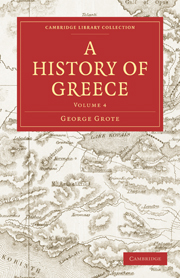Book contents
- Frontmatter
- Contents
- PART II CONTINUATION OF HISTORICAL GREECE
- CHAPTER XXV Illyrians, Macedonians, Pæonians
- CHAPTER XXVI Thracians and Greek Colonies in Thrace
- CHAPTER XXVII Kyrênê.—Barka.—Hesperides
- CHAPTER XXVIII Pan-Hellenic Festivals—Olympic, Pythian, Nemean and Isthmian
- CHAPTER XXIX Lyric Poetry.—The Seven Wise Men
- CHAPTER XXX Grecian Affairs during the Government of Peisistratus and his Sons at Athens
- CHAPTER XXXI Grecian Affairs after the Expulsion of the Peisistratids.—Revolution of Kleisthenês and Establishment of Democracy at Athens
- CHAPTER XXXII Rise of the Persian empire.—Cyrus
- CHAPTER XXXIII Growth of the Persian Empire
- CHAPTER XXXIV Dêmokêdês.—Darius invades Scythia
- CHAPTER XXXV Ionic Revolt
- CHAPTER XXXVI From Ionic Revolt to Battle of Marathon
- CHAPTER XXXVII Ionic Philosophers.—Pythagoras.—Kroton and Sybaris
- Titles in the Series
CHAPTER XXVI - Thracians and Greek Colonies in Thrace
Published online by Cambridge University Press: 29 August 2010
- Frontmatter
- Contents
- PART II CONTINUATION OF HISTORICAL GREECE
- CHAPTER XXV Illyrians, Macedonians, Pæonians
- CHAPTER XXVI Thracians and Greek Colonies in Thrace
- CHAPTER XXVII Kyrênê.—Barka.—Hesperides
- CHAPTER XXVIII Pan-Hellenic Festivals—Olympic, Pythian, Nemean and Isthmian
- CHAPTER XXIX Lyric Poetry.—The Seven Wise Men
- CHAPTER XXX Grecian Affairs during the Government of Peisistratus and his Sons at Athens
- CHAPTER XXXI Grecian Affairs after the Expulsion of the Peisistratids.—Revolution of Kleisthenês and Establishment of Democracy at Athens
- CHAPTER XXXII Rise of the Persian empire.—Cyrus
- CHAPTER XXXIII Growth of the Persian Empire
- CHAPTER XXXIV Dêmokêdês.—Darius invades Scythia
- CHAPTER XXXV Ionic Revolt
- CHAPTER XXXVI From Ionic Revolt to Battle of Marathon
- CHAPTER XXXVII Ionic Philosophers.—Pythagoras.—Kroton and Sybaris
- Titles in the Series
Summary
That vast space comprised between the rivers Strymon and Danube, and bounded to the west by the easternmost Illyrian tribes, northward of the Strymon, was occupied by the innumerable subdivisions of the race called Thracians or Threïcians. They were the most numerous and most terrible race known to Herodotus: could they by possibility act in unison or under one dominion (he says), they would be irresistible. A conjunction thus formidable once seemed impending, during the first years of the Peloponnesian war, under the reign of Sitalkês king of the Odrysæ, who reigned from Abdêra at the mouth of the Nestus to the Euxine, and compressed under his sceptre a large proportion of these ferocious but warlike plunderers; so that the Greeks even down to Thermopylæ trembled at his expected approach. But the abilities of that prince were not found adequate to bring the whole force of Thrace into effective co-operation and aggression against others.
Numerous as the tribes of Thracians were, their customs and character (according to Herodotus) were marked by great uniformity: of the Getæ, the racter. Trausi, and others, he tells us a few particularities.
- Type
- Chapter
- Information
- A History of Greece , pp. 26 - 38Publisher: Cambridge University PressPrint publication year: 2010First published in: 1847

